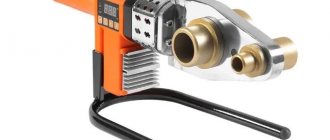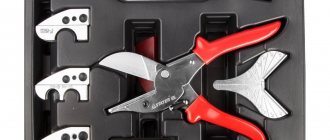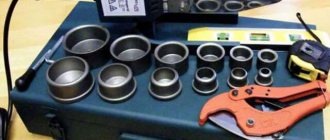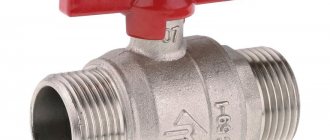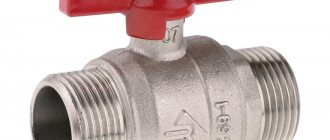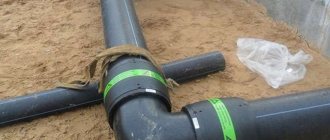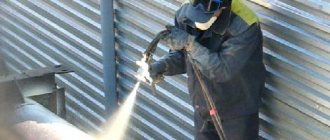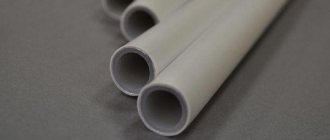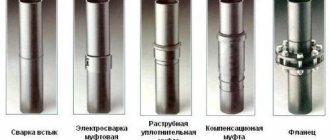When carrying out installation work on the arrangement of pipelines for heating, water supply or sewerage systems made of plastic pipes, cutting the material becomes a very frequent operation. It is not recommended to cut pipes with improvised tools, as this complicates subsequent installation and negatively affects the quality and reliability of the connecting units.
Pipe cutter for polypropylene pipes
For such purposes, a special tool is used - a pipe cutter for polypropylene pipes. This device is designed to produce neat, burr-free cuts strictly perpendicular to the pipe axis, which ensures ideal joints with a variety of connecting parts or shut-off valves.
It would seem - what is the problem with purchasing such a tool for cutting pipes? But it turns out that there are certain nuances of choice here too.
Variety of pipe cutters for polypropylene pipes
In specialized stores, customers are offered various models of devices for cutting polypropylene (PP) pipes of different diameters. This tool can be either mechanical or electrical.
Each type has its own characteristics, advantages and disadvantages. To understand their design and make a choice, you should consider different options.
All cutting tools can be divided into scissors, guillotines, planetary mechanisms, and saws.
Most cutters are classified as precision hand tools—a definition that means “accurate.” That is, the cut turns out perfectly smooth and corresponds to the applied markings. Such cutters can have a ratchet, guillotine and roller design, which allows cutting PP with one hand without much effort.
The disadvantage of some pipe cutters (this is more true for scissors) is possible difficulties with centering the workpiece, causing the blades to move incorrectly, which leads to an oval cut. That is, if the pipe is not properly fixed, the blade may not cut at a right angle to the walls (axis).
Next, various types of products with manual action or electric drive will be considered.
Conclusions and useful video on the topic
The video will help you understand how the tool for cutting metal-plastic pipes works - watch how to cut a metal-plastic pipe:
With such a wide range of construction tools, both manual and electric, choosing a pipe cutter that will cope with its function, but will not cost more than the heating system itself, is a very real task.
Knowing what types of devices there are, as well as getting acquainted with the most popular models, you can easily choose and buy equipment for working with metal-plastic pipes.
Would you like to add useful comments to our material or share your own experience in cutting metal-plastic pipes? Or do you want to talk about the pros and cons of your pipe cutter? Write your opinion and recommendations under this article, add unique photos of your model of pipe cutters or the cutting process itself.
Hand tools
Guillotine pipe cutter
The simplest design option for scissors is the guillotine design. This tool can be mechanical or electrically driven. Electric models are professional tools needed when regularly performing large volumes of work.
In addition, guillotine pipe cutters are divided into tabletop and manual models.
Tabletop (floor) pipe cutter
The design of a tabletop (floor) pipe cutter is a kind of frame, inside of which a movable blade is installed, progressively moving vertically. It is activated by the rotation of the upper handle or flywheel, and is lowered at a right angle onto the pipe placed in the saddle of the lower part of the frame, making a perfectly straight cut.
Tabletop guillotine pipe cutter
When lowering the blade, the load from it is evenly distributed over the surface of the pipe, which ensures an even, burr-free cut, while maintaining the correct cross-sectional shape of the product. Since the polypropylene walls are not deformed when the blade is applied to the pipe, the end does not require additional processing. The cut section is ready for butt welding using a coupling or other mounting part or fitting.
Benchtop pipe cutters are typically designed to work across a wide range of plastic pipe diameters. They are used when installing any pipelines - water supply, heating, sewer. There are devices designed for very large diameters, and they are not tabletop, but stationary floor-mounted, and are usually used only in industrial settings.
The disadvantage of this type of pipe cutter is that the speed of work is not very high. This is understandable - before each next cut, the blade must be returned to its original position, which requires turning the rod.
Prices for pipe cutters
pipe cutter
Manual guillotine pipe cutters
These tools have a scissor-like design and are designed to cut pipes up to 70mm in diameter.
The advantages of manual guillotine cutters are their compact size, ease of storage and operation, and high speed of cutting operations. In addition, the dimensions of the tool allow it to be used in limited spaces, which is often the case in plumbing installations.
Manual guillotine pipe cutter
Guillotine shears also have plenty of disadvantages. These are hand fatigue during a large volume of work, the high cost of replacement blades, deformation of the walls during cutting, the presence on the market of a large number of low-quality products that will fail after several cuts, and limited pipe diameter.
The logical conclusion is that this type of pipe cutter is well suited for performing small amounts of work when installing pipes of small diameters.
The process of working with a manual guillotine pipe cutter is practically no different from using conventional scissors. True, there are also some peculiarities:
It is best to mark the pipe with a marker of a contrasting color
- The first step is to make a mark on the pipe along which the cut will be made.
- Next, the pipe is laid on the wide base of the tool so that the mark left on the pipe is located exactly under the blade of the knife located on the other side of the scissors.
- Then you need to press down on the handle, which will lower the blade onto the pipe, and apply full compression until the cut is made.
- And finally, the force is removed from the handles, the tool returns to its original position.
Simple, but not convenient enough.
Ratchet pipe cutter
Scissors with a ratchet mechanism are equipped with a toothed sector and an intermediate position lock. Thanks to this design, the knife gradually lowers onto the pipe being cut.
When force is applied to the handles, the blade does not move like a scissors until it is fully aligned with the base for the pipe, but only to a certain angle, and is fixed in this position. The click of the ratchet mechanism indicates that you can release the handles of the pipe cutter - they themselves will move back to their original position position under the action of a spring. Then, from this position, the most convenient for applying force, another press is made, which also causes the blade to shift - and so on until the cut is completed.
Ratchet shears for cutting polypropylene pipes
Unlike the guillotine version of scissors, ratchet pipe cutters have not only a different mechanism of action, but also a blade of a different shape. The lower part of the tool, that is, the stop for placing the workpiece, is similar, that is, it is given a semicircular shape, convenient for laying pipes of different diameters.
Thanks to the ratchet mechanism, cutting is much easier, so your hand gets less tired.
The disadvantage of a ratchet cutting device is the likelihood of jamming the polypropylene walls and possible bevel of the cut.
Using this tool requires some skill. The main difficulty lies in the ability to hold it in the correct position so that the blade is positioned exactly perpendicular to the pipe being cut. Otherwise, the cuts will turn out oblique and will have to be further processed. If the pipe cutter jams the pipe (for example, due to insufficient blade sharpness), then after cutting it will have to be straightened from the inside using a calibrator.
Pistol pipe cutter - with this tool it becomes much easier to correctly install the pipe under the knife
This type of cutting product also includes pistol pipe cutters equipped with a ratchet (ratchet) mechanism. This tool is easier to handle, and the cut with it is more accurate and even. Returning the blade to its original position in this design is carried out by pressing a button, which activates the spring. The pistol variety is well suited for cutting pipes with hard or thicker walls. But the cost of such pipe cutters is significantly higher.
Planetary type pipe cutters
Roller pipe cutters
This type of pipe cutter is a planetary type tool. It differs in both design and operating principle. Similar products are produced in a specific range of sizes and are designed for cutting pipes of different diameters.
Externally, the roller pipe cutter cannot be confused with any other because of its characteristic shape.
Roller pipe cutter – provides a very accurate and even cut of the workpiece
The design of a roller pipe cutter consists of the following parts:
- The body is made in the form of a hook.
- The movable handle, which is also a clamping mechanism, can be lowered and raised, depending on the diameter of the pipe being cut.
- At the end of the clamping part there is a cutting blade in the shape of a wheel (roller).
- At the bottom of the hook bend there is one or more movable rollers against which the wall of the pipe being cut will rest.
- Some models are additionally equipped with a cutter that chamfers the cut end of the pipe.
Cutting a pipe using a similar tool is carried out as follows:
- The pipe is laid on movable rollers, inside the lower part of the hook. The cutting mark placed on it should be in the center
- The handle with the disk blade should be lowered to the surface of the pipe - the position of the workpiece is adjusted - precise alignment of the applied mark with the blade. After this, the blade is pressed all the way.
- Next, you need to grab one free end of the pipe and twist it a full turn inside the tool. If a very long section is being cut, or for other reasons it is simply impossible to rotate the pipe, then the pipe cutter itself is rotated 360 degrees around the pipe.
- Having made the first pass, the blade should be lowered down using the handle a few more millimeters.
- Then the operation is repeated. The roller blade will not move anywhere and will pass exactly along the groove left on the surface of the pipe.
- Such passes are repeated until the pipe is completely cut off. Their number will depend on the thickness of the polypropylene wall and the sharpness of the blade.
If you use the tool correctly, accurately holding the blade on the mark, the cut will be perfectly straight. The main thing is to make the first furrow accurately - the next passes will be easier to make.
When working, you should remember that you should not immediately press the blade against the surface of the pipe very strongly, since microcracks may form along the edge of the cut, which will reduce the strength of this section of the product, so chips may appear at the end of the pipe. When making cuts, you should not rush - all turns should be smooth. This is especially important to consider when cutting products with large diameters or thick walls.
In terms of evenness of the cut, the planetary roller device is comparable to the stationary guillotine version of the pipe cutter, but working with it is much faster. However, the cost of this tool is higher.
The advantage of a roller pipe cutter is that there is no application of strong starting pressure on a local section of the plastic pipe wall. The cut is made evenly in a circle, which means that the blade will not crush the pipe even if it has thin walls.
Chain pipe cutter
A pipe cutter with a chain mechanism also belongs to planetary tools. It can be used to cut pipes in a wide range of diameters, so it can be called a very practical tool, especially for those craftsmen who are constantly involved in the installation of various piping systems. At the same time, such a pipe cutter has a considerable cost, so not everyone can decide to purchase it.
The design of chain pipe cutters may vary, but the most common option is a model that looks like pliers with a chain attached to the ends. The chain links are connected to each other by hinges, on the axes of which there are rollers that act as cutters.
Design of a chain pipe cutter designed for cutting workpieces with a diameter of 25 to 85 mm
In most cases, the chain is non-separable, so if one of the hinges breaks, it will have to be replaced completely, since this structural element is initially a consumable item.
Prices for chain pipe cutter
chain pipe cutter
As a rule, this type of pipe cutter is used for cutting not only polypropylene, but also copper and steel pipes. Therefore, the tool can be called universal.
Pipe cutting with such a tool is carried out in the following order:
- A pipe is inserted into the circle formed by the chain and positioned according to the cut mark.
- The chain is then tightened on it using the T-handle on the top handle.
- After this, you need to grab the handles of the tool, apply a bringing force, and then perform several arc movements up and down relative to the axis of the pipe. Since several roller cutters are involved in the cutting process, there is no need to rotate the tool completely 360 degrees.
- If you need to cut a pipe that is already installed in the system, you need to unfasten the chain from one side of the pliers. Then wrap it around the pipe and secure it again in its original position. Then pull the chain to the pipe with the flywheel and carry out several cutting movements, as far as space allows. Even in tight conditions, the result is guaranteed, with high cutting precision.
Chain pipe cutters are divided into two types according to the fastening of the cutting elements:
- Movable incisors. In these models, the rollers simultaneously act as hinges and cutters. That is, during the cutting process they rotate - the cutting edges do not wear out so quickly
- Fixed cutting elements are rigidly mounted on the axes of the hinge joints of the chain and remain in one position during the pipe cutting process. It is clear that such edges will dull faster.
The advantages of pipe cutters with chain mechanisms include the following:
- Fast cutting of products due to numerous cutting elements simultaneously acting circumferentially on the pipe wall.
- Five chain links form an overlapping cutting angle of only 72 degrees, which allows this type of tool to be used in confined spaces.
- There is virtually no risk of deformation of the pipe walls due to the fact that the cut occurs at several points at once.
- Pipe cutters of this type can cut products with different diameters in a fairly wide range.
- The output is a perfectly even cut, without the formation of burrs.
The disadvantage of a chain pipe cutter is its high price. By the way, this circumstance encourages some craftsmen to make such an instrument on their own.
Video: Homemade chain pipe cutter
Electric pipe cutters for polypropylene pipes
The presence of an electric drive in the tool significantly speeds up and facilitates both installation and dismantling work when creating, repairing or modernizing water supply, heating or sewerage systems. At the moment, there are several types of electrical appliances:
- A tool that, in principle, copies the design of the roller and guillotine mechanism of a pipe cutter, but with force transmission from an electric drive.
- Power saws.
- Stationary equipment used in industrial settings. Such devices are universal, as they are suitable for cutting products from different materials.
To understand what electric tools are, they need to be examined in detail.
Reciprocating electric saw
Reciprocating electric saws are versatile and are used for cutting many materials, including pipes. Such a tool usually has a convenient configuration with handles that provide a secure and comfortable hold. A serrated blade is installed in front, which performs reciprocating movements when performing work. The length of the cutting blade, its width, and the pitch of the teeth are selected depending on the material to be cut. For plastic pipes, blades with fine teeth without wide routing are most often used.
A reciprocating saw can also be used as a pipe cutter. This is especially true for large diameter plastic pipes.
The design of some models of the device may include a C-shaped or chain clamping mechanism, which is designed to fix the pipe in the required position. It is attached to the saw body with a specially designed mount.
The advantages of this tool include the following:
- High productivity of work.
- Ability to cut pipes of various diameters.
- Affordable cost of replacement blades.
- Long service life of the device.
- The price of household models of electric saws is comparable to the cost of professional guillotine pipe cutters, but the functionality is incomparably higher.
The disadvantages of using a reciprocating saw as a pipe cutter include the following:
- Energy dependence. To perform the work, a source of electricity is required. Or a model equipped with a battery.
- A cut made with this tool requires additional processing using a chamfer or trimmer.
- It is difficult to make a perfectly perpendicular cut with a reciprocating tool if there is no clamping device or the pipe is not firmly fixed in a vice.
In a word, it is clear that purchasing a reciprocating saw solely for cutting pipes is hardly reasonable. Another thing is that if you already have it in your home “arsenal,” then you can do without purchasing a pipe cutter.
Guillotine and roller electric pipe cutters
Electric pipe cutters of the guillotine and roller type should rightfully be classified as narrow-profile professional tools. They have all the qualities of mechanical tools of the same design, but their price is much higher than the latter. Therefore, it is rational to purchase such power tools only in cases where the master works with pipes on an ongoing basis.
Electric roller pipe cutter.
Electric pipe cutters are similar to their mechanical counterparts only in operating principle, but have a more complex design. By the way, there are different options; they require connection to a regular 220-volt power supply; others run on a battery. This allows them to be used both at home and in conditions where there is no power supply. The battery charge lasts for one to two hours of uninterrupted operation. And since pipe cutting alternates with their installation, one charge can be enough for an entire shift. Convenient in conditions of construction on an uninhabited site.
Electric pipe cutters, by the way, can be used for cutting not only polymer, but also metal pipes.
Industrial pipe cutters
Industrial devices can have different designs and are used for all sizes of pipes, as they adapt to any diameter.
Depending on the design features, industrial pipe cutters are divided into electric, hydraulic, and pneumatic. Many of them are equipped with an automatic control system.
The equipment is intended for pipe cutting on an industrial scale, so it is irrational to consider it for home use. It has not only a high cost, but also quite large sizes.
Which pipe cutter should you choose, mechanical or electric?
When you plan to carry out installation work on laying pipes yourself, you cannot do without a cutting tool. Therefore, the question of which device is better to purchase, mechanical or electrical, is quite relevant.
Cutting pipes with a reciprocating saw.
- If a large amount of work is planned that will be carried out in a private house at the stage of its construction, then it is more rational to give preference to a reciprocating electric saw, which will subsequently come in handy more than once during the construction of the building and further on the farm. But you can get by with a manual model of a pipe cutter, of high quality, so that it is enough to create all engineering systems where pipes are used.
- If your plans are to engage in the installation of pipelines on an ongoing basis, then a guillotine or chain pipe cutter is best for mechanical options, and for electrical types it is better to purchase the same reciprocating saw.
- When choosing a power tool, do not forget that it will require power supply, which is not connected at all facilities. Even a battery-powered device requires periodic recharging. Therefore, the presence of a power tool often does not eliminate the need to also have a manual one in stock.
- If the work will be carried out in an apartment and one-time, then, as a rule, one of the simplest inexpensive mechanical models is purchased. They are more affordable and easy to use.
Using a manual guillotine pipe cutter at home.
- For work in an apartment, a compact manual mechanical pipe cutter is more suitable, which can be used in small spaces. This will allow pipes to be cut directly at the site of their further installation.
In order for the pipeline assembly to be of high quality, you must learn how to use any of the pipe cutter models. Therefore, before making a “finish cut”, you should get your hand a little on a piece of pipe. The cost of polypropylene pipes is low, and you can always afford to buy an extra meter for such training, and in general - just in case. Such an “optional” will help you understand the principle of operation, as well as gain at least a small, but for a beginner, invaluable preliminary experience before starting installation.
How to use it correctly
How to cut a pipe straight? review of pipe cutters
The technique of cutting with scissors is not difficult to master. The main thing is to adhere to this sequence:
- measure the distance on the pipe, mark control points with a marker;
- position the pipe section in the pipe cutter so that the cutter takes a position above the mark;
- press the handle of the tool with a strong but smooth movement, while it is important to ensure that the material being cut is placed strictly perpendicular to the scissors;
- If necessary, treat the resulting cut with fine abrasive.
Pipe cutting is carried out in compliance with safety precautions. The blades of the tool must be sharp enough and there should be no signs of damage on the body. Using a pipe cutter, you can cut long sections of pipe, but not less than 2 of its diameters. When cutting parts that are too short, the cutter may slip.
It is unacceptable to use lubricants and other liquid solutions during operation to facilitate cutting workpieces. During the soldering process, these products can create defects, which will affect the quality of the connections.
Do not use scissors designed for smaller diameters to cut pipes. It is better to purchase a suitable pipe cutter model.
Criteria for choosing a quality tool
To ensure that your plumbing, heating or sewer system is reliable and lasts for a long time without accidents, you cannot do without a pipe cutter. And an even cut is especially important if pipes are prepared for diffuse welding.
However, you need to choose the right tool for the job. As mentioned above, the model must correspond to the complexity and volume of work to be done. But besides this, when purchasing a device you should pay attention to the following points:
Guillotine manual pipe cutter with steel blade
Prices for guillotine pipe cutter
guillotine pipe cutter
- The blade of the tool must be made of alloy steel.
- Each pipe cutter model has two key parameters - the maximum and minimum pipe diameter. When purchasing, these indicators should be selected so that one pipe cutter, if possible, is suitable for all pipes planned for installation in your systems.
- If you decide to go with a reciprocating saw, then you should pay attention to the length of the purchased blade for cutting pipes. It should definitely be longer than the diameter
- When choosing a hand tool, it is recommended to purchase a model whose body is made of metal, and it is better if it is high-quality aluminum. Such pipe cutters are lightweight, so working with them is more convenient and productive. Aluminum tools do an excellent job of cutting polypropylene pipes.
- In addition, it must be taken into account that pipe cutters can have replaceable or permanent blades. Over time, these cutting edges wear out and become dull. The permanent incisors will need to be sharpened (and you still need to know how to do this), and the removable blades can be quickly replaced with new ones. If the tool is purchased for one-time use, then it is worth purchasing a pipe cutter with a non-replaceable blade, simply because it is cheaper.
We can give some recommendations on which pipe cutter would be the best option for a particular type of work (with the expectation of purchasing or renting):
- Installation of a sewer system in an apartment or house, performed one-time - with a chain or roller pipe cutter, or a reciprocating saw.
- Frequently performed work with pipes in a private home or workshop, including - for the purpose of providing services - a manual guillotine or roller, an electric pipe cutter, or a reciprocating saw.
- For cutting polypropylene pipes with a diameter of less than 50 mm, a manual guillotine pipe cutter with a ratchet mechanism will be sufficient.
- Cutting PP pipes with a diameter of 50 mm and above, as well as thin-walled products - a roller or chain pipe cutter.
The final choice of product depends on other factors, but the recommendations given are still indicative.
Find out how to solder polypropylene pipes by studying the instructions and a lot of useful recommendations in a special article on our portal.
Advantages of working with polypropylene
The advantage of polypropylene pipes is their ability to withstand sub-zero temperatures without bursting. This is especially true in country houses, where gas and electricity supplies may disappear from time to time. That is why owners of cottages and summer houses prefer to use polypropylene pipes in plumbing systems.
In turn, the presence of scissors for cutting polypropylene pipes allows you to instantly correct problems that arise in your home pipeline. Simply cut out the damaged part of the pipe and replace it with a new one. In this case, all work will take no more than half an hour. But if there are metal pipes, replacing a section of the pipeline will take at least several hours.
In general, polypropylene communications are successfully used at temperatures up to sixty degrees. If there is a need to transport liquid up to ninety-five degrees, then reinforced pipes are used, equipped with a thin aluminum shell on the outside. It is this shell that prevents sagging and softening of products.
Before welding, the outer shell on reinforced pipes must be cleaned. For this, there is a special knife that removes the aluminum coating exactly to the welding depth.
Today, some enterprises have begun producing products that are reinforced from the inside. In this case, preliminary cleaning is not required for welding.
What tool and how is it not recommended to cut polypropylene pipes?
Of course, in addition to the specialized tools listed above, polypropylene pipes can be cut with others, and those most often found in any home workshop are a hacksaw for metal or wood, an electric jigsaw or an angle grinder.
It is not recommended to cut pipes with a hacksaw for metal or wood.
However, it is necessary to take into account that as a result of the impact of such tools on the pipe, the cuts will often turn out torn, with numerous burrs, or with melted ends, and this is unacceptable for subsequent welding.
Therefore, before welding work, it is necessary to level and clean the ends of the pipes from damage and irregularities, otherwise the connections may not be strong enough. And such cutting of pipes often leads to problems during the operation of the pipeline.
- The “grinder” cannot be used because the rotation speed is too high - the plastic pipe will heat up and begin to melt. The same thing can happen when using an electric jigsaw if it is turned on at a high frequency of saw friction. And at low speed, the cut turns out torn, microcracks can form along the edges
- Whatever tool is used to cut pipes, you cannot put too much pressure on the polypropylene walls - this applies to both improvised and special devices. Excessive force may cause the edge of the product to crack or the material to jam. Such damage can in the future lead to rupture of the pipeline in the area of the connecting nodes.
- You cannot use a circular saw or band saw to cut polypropylene, since the material is quite fragile, so it cannot be avoided without damage in the form of cracks and chips. In addition, the pipe can simply be torn out of your hands under such an impact.
- It is also not recommended to use pipe cutters for cutting PP, which are intended exclusively for cutting metal products, since they often begin not to cut, but literally tear the plastic. The exception to the rule is universal pipe cutters, which can be used for any material.
Peculiarities
- Cutting can be done with only one hand, without requiring maximum tension.
- The blade of the scabbard usually has a toothed rack. It is due to its presence that the work of cutting polypropylene pipes is carried out quite simply.
If you need to get high-quality cutting without damaging the pipe, you cannot use cheap Chinese scissors. In addition, these products can withstand only a couple of cutting cycles. After this they become unusable.
Brief overview of pipe cutter models
As mentioned above, the pipe cutter model is selected based on its technical characteristics and purpose. The table below shows several options for manual pipe cutters in different price categories.
| Illustration | Brief characteristics and approximate cost of a pipe cutter |
| Pipe cutters for polypropylene pipes “SPARTA” are designed for cutting products with a diameter of up to 42 mm. Tool size 180x89x45 mm, weight - 275 g. The body is made of aluminum alloy with nickel plating. The pipe cutter has a reliable ratchet design that allows you to carefully separate a piece of pipe with a few movements. Country of origin: China. Scissors are attractive due to their low cost, which varies from 245 to 370 rubles in different stores. True, such a low price makes you think about the quality of the instrument. But for one-time work it is a completely acceptable solution. | |
| The KRAFTOOL EXPERT 23381-42_z01 pipe cutter is designed for cutting metal-plastic and polypropylene pipes. The tool has dimensions of 300×110×33 mm and a weight of 0.362 kg. The product is designed to meet the high demands of professionals. The blade of the scissors, as well as the internal ratchet structure, is made of high quality alloy steel. This material provides excellent cutting ability and has a long service life. The pipe cutter is equipped with a replaceable blade, which will help increase its service life. Ratchet design promotes precise, straight and easy cutting. The pressure can be applied effortlessly using one hand. The pipe cutter was developed in Germany, so the German brand was retained, but made in Taiwan. The approximate cost of such a model is from 760 to 1050 rubles. | |
| Scissors "GROSS 78420" will be a good addition to the toolkit in your home workshop. Using this model, you can easily cut not only polypropylene pipes, but also rubber hoses, as well as plastic profiles with a semicircular shape. The pipe cutter is designed for a maximum diameter of 36 mm. The scissors have a six-speed ratchet mechanism and a trapezoidal blade made of SK5 high-carbon steel. The body is made of heavy-duty aluminum alloy, which guarantees the strength and durability of the tool. In addition, the compact and easy-to-grip handle with anti-slip pads will greatly facilitate the cutting process. The color design of the pipe cutter may vary, in addition, the manufacturer reserves the opportunity to change the complete set of the tool. The weight of the scissors is 400 grams. Country of origin: China. The estimated cost of the product is from 1345 to 1850 rubles. | |
| The ROTHENBERGER ROCUT TC pipe cutter is designed for cutting polypropylene, polyethylene and other plastic pipes with a diameter of up to 42 mm. The design is made of high-strength aluminum alloy, which guarantees the accuracy of cutting workpieces, as well as the durability of the tool. The ratchet mechanism is smooth, allowing you to cut thin-walled pipes without deformation. You don't have to put in much effort when working with this tool. The pipe cutter is equipped with a replaceable V-shaped blade, which is made of stainless tool steel, which also contributes to its durability. The upper part of the handle has a rubberized pad, which eliminates the risk of your hand slipping during operation. The tool is equipped with a quick knife return button and a safety lock that holds the blade until the button is pressed. The weight of the product is 400 grams. Country of origin: Germany. The price of a pipe cutter is considerable - from 3800 to 4200 rubles, but considering the quality and durability, it is worth it. | |
| The RIDGID 154-P pipe cutter is designed for cutting any plastic, metal thin-walled, as well as multilayer metal-plastic pipes with a diameter of up to 110 mm. The tool has a planetary type roller cutter, so pipe cuts are made quickly, easily and very accurately. The design allows you to change the pipe cutter to a different pipe diameter in a few seconds. The cutting element, made of alloy steel, gives smooth and clean cuts. The tool comes with a spare cutting roller. Models numbered 151 and 152 additionally have a built-in device - a countersink, which allows you to remove burrs from the end of the pipe. The pipe cutter body is made of high-quality durable aluminum alloy. The design provides a return mechanism for the cutting element. This brand belongs to a US company, and the tool is manufactured in Germany. The average cost of a model is about 13 thousand rubles. | |
| The Milwaukee C12 PPC-0 (PEX) electric pipe cutter, equipped with a battery, weighs 1.5 kg. When cutting pipes, the tool creates a pressure of 175 kg/cm² and has the power to cut a pipe with a diameter of 50 mm in three seconds. The device is equipped with a system for adjusting the cutting speed of plastic products. The battery is designed for 200 cuts on one charge, and the indicator located on the body of the pipe cutter notifies you of the need to recharge or change the battery. In addition, the tool is equipped with a backlight, allowing you to work in low ambient light. The disadvantage of this product package is that it does not include a battery and a charger - they are purchased separately. The owner of the “Milwaukee” brand is a US company, the country of origin of the product is Germany. The average cost of the tool is (without battery and charger) 12500÷13200 rubles. |
That's all. We hope that having understood the question of what pipe cutting devices are, the reader who has received this information will be able to decide on the choice of the optimal pipe cutter model, taking into account his needs and capabilities.
In conclusion, an entertaining video about one interesting model of pipe cutters “RIDGID”.
Voting for the best scissors for cutting plastic pipes
Which scissors would you choose or recommend for cutting plastic pipes?
Knipex KN-902540
0.00 % ( 0 )
ROTHENBERGER Rockat 42TS
14.29 % ( 2 )
Kraftool 23410-42
35.71 % ( 5 )
Ridgid 1442N
0.00 % ( 0 )
Fit 63mm Matrix
7.14 % ( 1 )
Virax RS-32
0.00 % ( 0 )
Heisskraft N-40 R
0.00 % ( 0 )
Yato YT-2228
0.00 % ( 0 )
Milwaukee Heavy Duty
7.14 % ( 1 )
KALDE GM Cobra
7.14 % ( 1 )
VALTEC, diameter 40 mm
21.43 % ( 3 )
BISON EXPERT 23705-42
7.14 % ( 1 )
